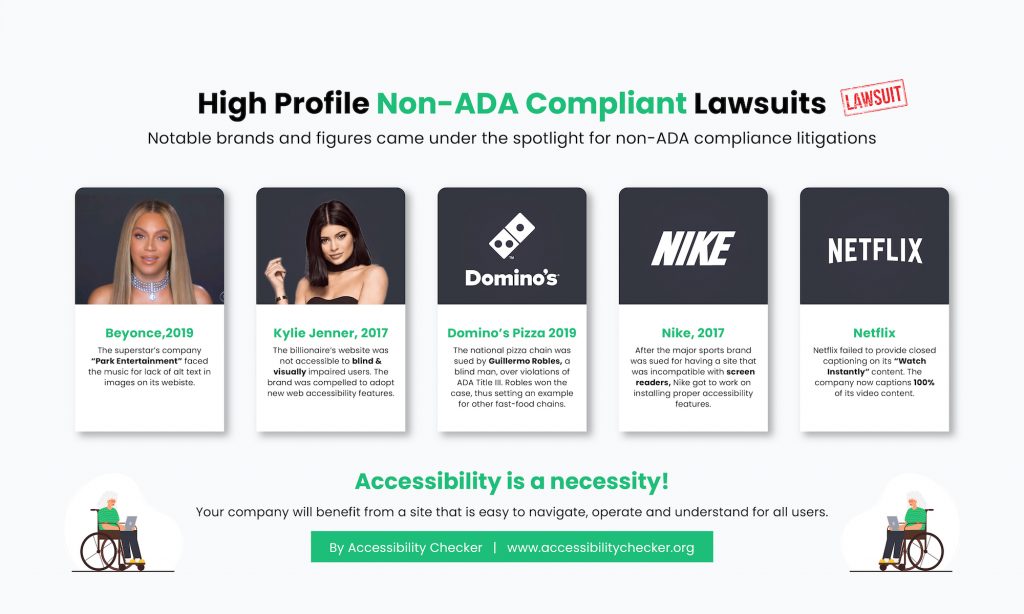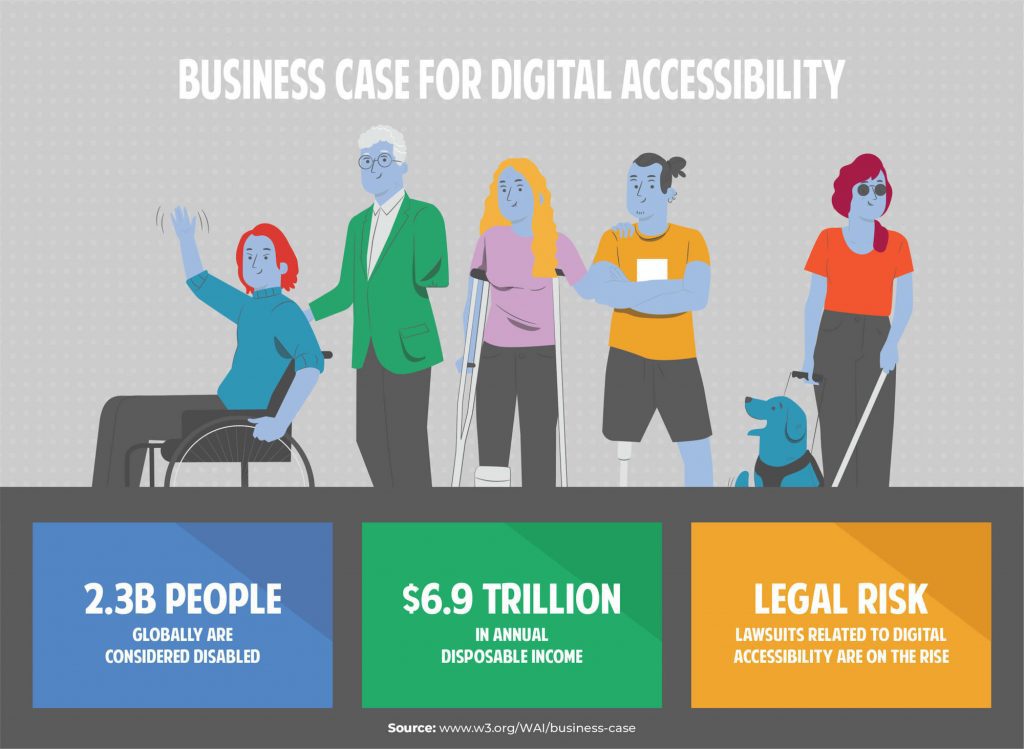
Estimated reading time: 21 minutes
Can you remember a time without the Internet? Probably not, but even if you can it’s hard to imagine living without it in the 21st century. You have all of the knowledge that you would ever need in your pocket at almost all times. Over half of the world’s population has access to the Internet, which accounts for over four billion people. Today we are going to give you an ADA compliance guide for websites in 2023.
Similar Posts
The Internet has been known to be responsible for changing the way human beings connect, communicate, and interact together. That’s why this ADA compliance for the web – A complete guide will help website developers, web designers, marketers, and business owners alike. Oh and is ADA compliance mandatory for websites?
There is one group of people that have trouble accessing the Internet. Individuals with a disability either can’t access it at all or have major difficulties using it. The main reason people with disabilities have issues accessing the Internet is that most websites aren’t set up with ADA standards as a consideration when being designed and developed.
If just one website isn’t compliant it can stop millions of users from reaching all websites on the Internet, which means they miss out on major benefits. Creating an accessible Internet for everyone is starting to be the first thing on every web developer’s mind and is starting to be at the top of the list when it comes to important aspects of a website’s design.
This guide about web accessibility is to help you understand ADA website compliance and how it looks online. We’ll also explain why having a website that is accessible or in ADA compliance matters. We will include resources to help guarantee your website and any website that you work on is within ADA compliance and accessible to most people.
It goes without saying the information here is most important to those with a disability and web designers. It is relevant to anyone that uses the Internet in general. Having an accessible website has an impact on the Internet & every user. It’s not just an issue for people with a disability or website owners.
Developers who create ADA website compliance sites are creating universally accessible sites and can ensure anyone can utilize the Internet in an accessible way. The way it was supposed to be used.
ADA Compliance Standards For Designers And Developers Explained For 2023
The Americans with Disabilities Act was passed in 1990 and it prohibits discrimination in each person’s public life based on disabilities. This includes your place of employment, schools, public transport, and any other public places.
This means employers are required to make sure their employees are accommodated, by having public accommodations, if they have disabilities. The Americans with Disabilities Act also mandates requirements that make public locations accessible. The ADA has ensured great strides for people living with a disability to help make their life easier.
The big problem is that these ADA regulations haven’t seen the same type of implementation on the Internet. Lawmakers have adjusted slowly to the virtual world. At this point, 11 years after the Americans Disability Act Amendments, we haven’t seen changes to federal laws that require websites to become ADA compliant.
Google has tried to have an impact by pushing sites to make accessibility a bigger part of their designs by giving compliant websites a higher spot in the search results. Despite that, there are many hurdles to jump until we see the entire Internet accessible.
Figuring Out Section 508 Compliance

Section 508 is an amendment to the Rehabilitation Act of 1973. Section 508 passed in 1998 and dictates that federal agencies make sure their information & communication technologies are in ADA website compliance for individuals with a disability. Section 508 states “websites or other technology can only be considered in compliance if a person who has a disability can effectively use it the same way a non-disabled person can”.
There are exceptions, meaning not every federal agency has to be compliant with Section 508. There are different reasons for exceptions, which include access to maintenance and national security. Other entities that are affected by this compliance are federally funded non-profits, public schools, public colleges, & universities.
If you don’t fall under Section 508, it is still very important that website design agencies and other Information Technology professionals think about making your sites compliant. While you are making your website ADA compliant it’s not a good idea to leave anyone out. You especially have to be sure not to leave out your target audiences. Making your site even more accessible isn’t that complicated and believe it or not most things are fairly easy.

Some Of The Things You Need To Do To Ensure Your Website Is Section 508 Compliant
- Increase The Readability Of Text For A Screen Reader To Convert Audio.
- Transcribe Audio Clips.
- Transcribe Video Clips.
- Make Sure Visual Elements Include A Description Or Alt Text.
You can check out all of the Section 508 requirements here.
Why Does ADA Or Website Accessibility Matter

As stated before, people with a disability should be allowed to access the web the same way users without a disability do. The use of the Internet is a huge part of the day-to-day activities of almost everyone. If you have a disability, you have the same rights as everyone else to easily access the web.
Not only that but the World Health Organization (WHO) estimates that around 15% of the world’s population is disabled. That’s about 1 billion people which makes people with a disability a big number of the total population.
There simply aren’t very many websites that are ADA compliant and therefore most sites aren’t useful to users with a disability. There was a study done in 2020. The WebAIM Million says out of the top 1 million site homepages on the net, 97.8% have a detectable web content accessibility guideline (WCAG 2) error.
This leads to an obvious bad user experience. This study was only analyzing the main pages of sites. All of the tests used were automatic. The study confirms most assumptions that suggest that accessibility overall is extremely low for those with a disability.
The Internet can be difficult for people without disabilities. For people with a disability, it’s even more difficult if not impossible to navigate. But, people with disabilities aren’t the only reasons to make sure your website is accessible. You will see additional advantages when you create a universally accessible site.
These things will benefit those with a disability, those with a website, and those who simply use the Internet.
Things Being ADA Compliant Help Non-Disabled Users
- Create A Better Site – As a rule of thumb, websites that are universally accessible are better. If developers follow ADA website compliance steps it can help them design and develop higher caliber websites. A lot of the guidelines overlap with the best practices of web development and design.
- Avoids Legal Issues – Having a website that is ADA compliant will help you stay ahead of any possible legal issues in the future. You won’t have to worry about discrimination claims from individuals with a disability. Having a site that is compliant shows you can work with many government agencies and non-profits that require their sites to be ADA compliant.
- Improves Usability For Everyone – Making websites easier to navigate helps users that are disabled and people without a disability. Everyone can benefit from a website that has better usability which improves your overall user experience.
- Broadens Audiences – Being ADA compliant means your website is universally accessible which makes it easier for more people to use. This leads to more users, more traffic, and in the end more customers. Being accessible will not guarantee you an increase in your bottom line, but it allows you to increase your audience and this could raise awareness for your business.
- Normalizes Accessibility – The more websites that are designed to be ADA compliant helps to make accessibility the norm. When it’s normalized it can help more people trying to reach the required goal easier across the board.
- Improves Your SEO – This is a no-brainer. Having an accessible site improves your SEO rankings. We discussed above how Google gives websites that are accessible a higher priority in the SERPS. Not only that, but accessibility features will improve the chances for search bots to index your website. As with website design, a lot of the ADA standards fit into SEO best standards.
- Generates Positive PR – You can stand apart from your competitors by having an ADA compliant website that helps boost your company’s reputation. It shows that your company is thoughtful and inclusive to everyone.
An ADA Compliant Checklist For Websites

Being ADA compliant can be a tall order and the benefits are well worth it but can be daunting. Do you know what you need to accomplish to make a website compliant with the American Disability Act? A good web developer will plan for accessibility because good website developers start with a good marketing strategy.
Doing this leads to a high-quality finished product. If you need to you can complete the website overhaul after you’re finished, but if you want to do it right, you need to start prep when you begin designing the website.
Each person who is disabled is different, but there are specific site elements or features that can make each website easier to access for disabled individuals in general. If you are looking for a checklist with website features that helps your site be more compliant with the Americans with Disabilities Act, making it more usable for the disabled community. Here is the checklist you have been looking for.
Website Accessibility For The Deaf And Hard Of Hearing Individuals
You can improve any website’s accessibility for the deaf community. This also helps people who are partially deaf or hard of hearing. Here are some web accessibility best practices for the deaf community.
- Closed Captioning And Subtitles On Videos – Be sure to provide subtitles, also known as closed captioning, regardless of what language it’s in on all of your videos. Double-check your captions to make sure they are accurate and make changes if you need to.
- Audio Transcripts – If you have audio clips and for your videos provide a text-based transcript. Make sure your transcripts are accessible to the screen readers. This will also mean they are accessible to the SERP bots.
- Simple English – Do your best at avoiding slang, jargon, uncommon words, and complex sentence structure. Remember that for many deaf or hard of hearing people their first language is sign language and not English.
- Multiple Contact Options – Offer multiple methods to contact you. Be sure to include your phone number and at the very least an email address. Try to include a web form and your physical address.
Why Your Business’s Online Content Should Always Include Captions

Is your business website accessible for all customers, including those living with hearing impairments? If not, you could be missing out on a large segment of consumers, and you could also be missing out on compliance with federal accessibility regulations. To help your business meet those requirements, and also provide products and services for a wider swath of customers.
Here are some essentials to bear in mind when it comes to creating online content for those who are living with hearing loss or impairments.
Why Is Accessible Content Important?
If you haven’t thought about making your online content accessible for those with hearing loss or impairments, this may be your very first question. Not that it’s a callous question, since it’s always important for business improvements to provide a return on investment. Just know that upgrading your video and audio content to reach a wider audience of potential customers is never a bad idea.
According to some statistics, over 48 million adults in the United States are living with some degree of hearing loss. Hearing impairments are the third most common health issue for older adults. This means by ensuring your content is more accessible to these millions of potential viewers, you can boost your business.
What Are The Rules And Regulations?
Creating accessible content can boost business, but on top of that, Essential Accessibility notes removing barriers to content may also be required by federal regulations. Many small business owners are unaware that WCAG regulations require businesses to provide customers with disabilities with equitable service options.
With that in mind, if you offer things like instructional videos, you need to ensure that hearing-impaired consumers can enjoy the same benefits as others. You can utilize online transcription services to bring things up to speed, which can quickly create subtitles and transcripts for all of your audio and video offerings.
In addition to changes for visitors with hearing impairments, small businesses may also need to make other changes to ensure their websites are ADA compliant. Going beyond video and audio captioning includes things like alternative text, graphics that don’t flash more than three times per second and being able to fully navigate the keyboard. You can use a website testing tool to see how your site stands.
How Can Transcription Services Help With ADA Laws?

Filming videos about your products and services is a terrific way to bring traffic to your website. You can share them on social media, explain things to customers they wouldn’t already know, and develop a stronger relationship with your followers. That all falls flat when someone can’t hear what you’re describing, so adding the text allows hearing-impaired individuals to take full advantage.
Transcription services are much more affordable than paying an employee to transcribe content for you. Also, keep in mind, if you were to transcribe audio on your own, you could be looking at up to 6 hours to transcribe a single hour of audio or video content! Not to mention, you would need to spend additional time researching laws surrounding subtitles for the hearing impaired to ensure your captions meet those standards.
How Can Small Businesses Afford Accessibility Upgrades To Meet The ADA Laws?
If cost is still a concern, even with less expensive captioning options, you can always look for business funding opportunities for your web accessibility upgrades. You can use loans, credit cards, or even crowdfunding campaigns to pay for improvements, so be sure to research the pros and cons of each one before making a decision.
If you will be using transcription services regularly, covering those costs with a small business credit card that offers rewards may be your best bet. For instance, Inc. notes many business credit cards provide travel rewards on purchases made for your business, including those made for enhanced online accessibility. Be sure to save your receipts for any accessibility upgrades as well, since you may be eligible to receive tax credits to help offset the costs of those changes.

Ensuring that your content reaches a wider audience seems like common sense. If your small business is currently missing out on customers who live with hearing impairments, captioning can help change that. Being more inclusive is always good for business!
Website Accessibility For The Visually Impaired

These Elements Are Important To Anyone, But People With Visual Disabilities Can See A Huge Benefit
- Color Coding & Contrast – Make sure that color is not the main element used for your website’s meaning or to share information. Include adequate contrast with the font color and the page color to make it have more readable text. You need to offer several color schemes for users to choose pick from. This way they can choose the option that allows them to see the best.
- Alt Text For Pictures – All pictures and videos need to have some sort of description that goes along with them. The descriptive text makes it easy for screen-readers and search engine bots to easily understand your videos and pictures. Alternative text allows for the content to be read out loud. A website with good design is easy on the eye and accessible to the disabled. It needs to include this descriptive text so every website visitor can enjoy your website.
- Flexible text Size – Make your font size changeable, meaning allow your users to switch font sizes. This makes it easier to read each page. Don’t simply put font size into the code of the website.
- High-Level Descriptions – Create a unique title and header for each page and make sure each hyperlink has a unique anchor text. Not only should the title, header, and link be unique, but they should tell the user exactly what the page they are on is about. Be sure that the headers are formatted with a heading style and don’t just change the color, size, or font. Leave the underline under your hyperlinks. All of these things are SEO best standards as well and will help your rankings.
- Text & Not Images – Never put important information in images. Use text when you are conveying critical information. This way text to speech page readers will find it easy to read it out loud. If you have a critical image you need to include alt text and or description.
- Zoom Functions – Make sure zoom is useable on your website for your mobile site and desktop site. Make sure that you don’t disable the zoom function and that your website’s layout is adaptable up to 200% percent zoom on the desktop version.
- Screen-Readers Accessible – Create a website that is easily be processed with a screen-reader. This also allows for text-to-speech programs to easily read the text. Clearly identify all lists, links, and headers by adding descriptive terms that don’t use slang or jargon. Make sure all text on each page is concise, identified correctly, and simple to read. This makes the screen reads more capable to communicate all information from that page clearly.
ADA Website Compliance Considerations For Website Design & Other Issues

Other than the digital accessibility features that we have already discussed, there are many more elements that you should think about when it comes to your site design. A lot of these are what goes into creating a quality website anyway.
These Features Are Generally Found To Be Useful If They Are Disabled Or Not
- Text Summaries – Some people simply have trouble reading long sentences and paragraphs. You don’t need a disability to have this problem. Break up your text into small paragraphs, use headers and subheaders to make the text easier to read. Provide shorter summaries of the text. These are basic on-page SEO tactics.
- Size Of Links And Buttons – Keep your link sizes, button size, and any other touchpoint on your website a normal size. If the user isn’t utilizing a computer mouse it can be hard to click on the element as the element might be too small. You also need to guarantee the buttons aren’t too big. If they are too big a user with altered motor skills can click the button by accident.
- Avoid Animations, Popups & Autoplay – These elements can be extremely distracting and dangerous to some users. Be sure to always give the user a warning before any flashing or fast movement. Give the users a way to stop these features as they can cause seizures.
- Keyboard Accessibility – Create a site that is accessible for users that can only use their keyboard to get around your website. Pretty much every site allows you to get around using a mouse or touch screens on mobile. However, having access through a keyboard is a must for some users.
- CAPTCHAs – Traditional CAPTCHAs block access for users that cannot complete them and prevents certain people who are disabled from utilizing the website. To fix this ensure the CAPTCHAs are accessible or can be skipped over if a user isn’t capable of completing them.
- Multi-Touch – If you are thinking of putting fancy features that require users to complete two gestures at once or very quickly apart to access your website, think twice. Mostly seen on mobile devices, but these types of gestures can make it difficult for many people to access a site or app.
- Skip Top Level Links – Make sure that users who only use a keyboard & screen-readers are allowed to skip repetitive content. Your top-level navigation & headers can be considered repetitive content, make sure users can skip that type of navigation, and access your main content directly.
- Avoid Purchase Resets – You have seen a purchase time-out on websites such as Ticketmaster. It’s when sites kick you out of a purchase because you are taking longer than an allowed timeframe to finish their purchase. These pose major issues for customers. The user will find it to be a hassle to go back and add things to the cart again. Plus some users will take longer the second time or will simply leave your website.
How To Determine If Your Site Is ADA & Section 508 Compliant

If you aren’t positive if the website is compliant with the American Disability Act or compliant with Section 508 there are ways to find out. There are a few ways to check if your site is up to snuff for ADA website compliance and Section 508. You can utilize one of many web-based ADA accessibility checkers. They help developers or website owners test websites to verify if your site adequately meets the requirements or at least the expectations.
Here Is A List Of Several ADA Compliance Checking Tools That You Can Use
- Accessibility Insights – A Chrome extension that helps website designers and developers find accessibility issues on their websites.
- Section 508 Test For Accessibility – These are testing resources and other information or tips to help developers make sure the website they are developing meets the Section 508 standards.
- aDesigner – This is a program that simulates visual impairments. This will assist developers with verifying that users with vision issues can utilize the website without issues.
- Photosensitive Epilepsy Analysis Tool (PEAT) – Used to identify potential seizure risks in website content or the software being used.
- A11y Color Contrast Accessibility Validator – Use this tool to test the contrast of a web page. It will display color combos that don’t pass WCAG guidelines. It will also suggest solutions to any issues found.
- CynthiaSays – The CynthiaSays tool assists developers in finding accessibility errors with web content and compares the errors with Section 508 & WCAG guidelines. This tool will provide website designers with feedback on each page of the website.
- Android Developers Accessibility Tester – This is an accessibility testing tool that specifically pertains to Android mobile apps development.
- Readability Grader – You can use this website to make sure your content is easily read. This is one of many assistive technologies for ADA compliance.
We think the best way to guarantee that your site meets ADA compliance and is Section 508 compliant is to hire a trusted professional to help guarantee ADA compliance. Professionals know the ins and outs of being ADA compliant and will take note and fix any issues.
Some Additional Resources
You can find more information about these guidelines directly from Resources For Website Developers & Publishers as well as this important one. Google’s Initiatives & Research On Website Accessibility. Another resource that isn’t directly from Google is Interactive Accessibility which provides information about disabilities & web accessibility. It will also certify sites that meet specific standards.
Frequently Asked Questions About ADA Compliance For Websites
Basically, this means that your website needs to be accessible to people who have disabilities that affect their hearing, vision, or physical capacities. … Recently, a ruling has been passed declaring the official standard of website accessibility for businesses.
Do all websites have to be ADA compliant? Technically, the Americans with Disabilities Act (ADA) Title III, which concerns public businesses, does not specifically address websites. Local and state government websites must be accessible under Title II of the ADA and Section 508 of the Rehabilitation Act.
What does ADA compliant mean for websites? Your website provides full and equal access, effective communication, and/or meaningful access. In terms of preventing litigation, WCAG 2.1 AA conformance is the best practice.
You can also check your website for ADA compliance with a manual audit. A manual audit involves evaluating every page of your site for accessibility, using the Web Content Accessibility Guidelines (WCAG). WCAG encompasses a massive checklist, but it’s the basis for ADA compliance.
The ADA does not apply to religious organizations, private clubs, or any entity historically exempt from federal civil rights laws, such as places of worship and facilities controlled by religious organizations. (schools, daycares, etc.).
The ADA requires the Department of Justice to provide technical assistance to businesses, State and local governments, and individuals with rights or responsibilities under the law.
We hope our 2023 ADA Compliance For Websites guide helps you make your website ADA compliant.

